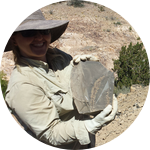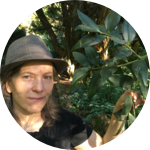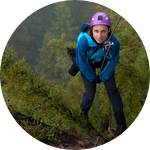About This Project
California’s two redwood species presently stand as Earth’s tallest, largest, most carbon-sequestering, and nigh oldest trees; their family’s fossils occur nearly globally. To better understand California redwoods' physiology and taxonomy, we study their stomata—pores—over canopy height. Are variations in their leaf stomata adaptive for vertical growth? Can species in the family be defined by them?
Ask the Scientists
Join The DiscussionWhat is the context of this research?
All plants breathe through stomata. Variations in stomata size and placement might help plants regulate their metabolisms and scientists recognize species.
Stomata variation might help explain redwoods’ vertical growth. Tall trees must be able to draw water in spite of friction and gravity. Certain aspects of leaf and branch structure have already been demonstrated to facilitate a gravity-defying flow. Are stomatal traits also adaptive? Will they show similar, linear, correlations with height?
Sequoioid—redwood family—fossils have been found across the globe. Their simple-shaped leaves can be difficult to differentiate, so stomata are used as identifiers. Coastal redwoods show high degrees of variation in stomatal traits but these haven't been well examined with height.
What is the significance of this project?
California's redwood forests set carbon-sequestration records among terrestrial forests. Coast redwoods grow close together with tall, deep, shady canopies. Giant sequoia, the runner-up, are relatively shorter, less densely spaced, less shade-tolerant, more drought-tolerant, and more massive. If a tree's water transport strategies falter—if gravity wins the tug-of-war or drought strikes—the tree sucks in pockets of air that might threaten its water flow capacity, growth, and even survival. Tall trees like redwoods, Doug fir and eucalyptus each manage this hazard in unique ways as they collaborate and compete. What role is stomatal variation playing?
Meanwhile, scientific communities continually update species classifications based on many traits, including stomata.
What are the goals of the project?
We aim to add additional leaves from our collection to the dataset, complete data visualizations, write a manuscript with Meriel as first author, and publish at least one paper in a peer-reviewed journal. The microscope slides will be relocated from the Looy Lab to the UC Berkeley herbarium.
Budget
Between 2010 and 2013, members of the Looy and Dawson Labs collaborated in the labor-intensive processes of collecting, preparing, and analyzing hundreds of California redwood leaves for a stomata study. In 2013, undergraduate Meriel Melendrez presented the preliminary findings, her honors thesis, at the Botanical Society of America meeting. Nearly a decade later, this otherwise unpublished data remains relevant to the scientific community. The stipend allows Meriel, with help from members of the original team, to complete the study and publish a manuscript in a peer-reviewed journal. It covers ~185 of her work-hours.
Any funding over the target will be used to cover open-access publishing fees—about $2,000 to make the paper accessible to the public. Additional generosity would help Meriel modify recent advances in AI-assisted microscopy and apply them to more of the prepared slides. Our team is seeking grants to add that method to this or a second paper.
Endorsed by
 Project Timeline
Project Timeline
We revived the project in Summer 2022. We expect to finish the manual technique aspects by early 2023 and apply AI-assisted methods, specifically machine learning for recognizing stomata in microscope images, by mid-2023.
Oct 10, 2022
Project Launched
Oct 19, 2022
Literature review
Nov 28, 2022
Data collection
Dec 14, 2022
Data analysis
Jan 12, 2023
First draft of the manuscript
Meet the Team
Affiliates
Affiliates
Team Bio
The Dawson Lab primarily studies the physiology of very tall trees. The Looy Lab studies leaf cuticles from fossilized conifers. In 2010, Cindy became curious about the variability in redwoods, so the Dawson Lab shared some of their samples. Now, Cindy is still in her lab, Meriel is betwixt institutions, and two members of the Dawson Lab, Anthony Ambrose and Wendy Baxter, founded the Ancient Forest Society, a non-profit that studies and cares for ancient living forests.
Meriel Melendrez Mees
My work spans ecological disciplines. I hold a bachelor's degree in Integrative Biology: Ecology and Evolution from the University of California, Berkeley and a master's in Social Science: Environment and Community from California Polytechnic Humboldt. I'm currently studying software engineering and machine learning with Codecademy. You can learn more at my website, meriel.systems.
The sketches in the project videos are from my undergraduate lab doodles; I took the photos in the field with a wee iPhone 4. I produced and narrated the films.
Pronunciation: Meriel (mehr-ee-el) Melendrez (mel-en-dr-ez) Mees (mace)
Pronouns: she/hers
Cindy Looy
I am a plant ecologist who tumbled down the rabbit hole of deep time. As a notorious subject hopper my interests are all over the place, however a common denominator in much of my work is the response of plants and plant communities to major environmental change and its evolutionary consequences. Although I like almost all things green (even after they stopped being green 100s of millions of years ago), I has a soft spot for conifers.
Pronouns: she/hers
Anthony Ambrose
Anthony Ambrose is a forest canopy physiological ecologist based in South Lake Tahoe, CA, where he serves as Executive Director of The Ancient Forest Society, a non-profit forest research and conservation organization. He received his BS and MS degrees from Humboldt State University and his Ph.D. from UC Berkeley. His research is focused on studying how climate change affects tree structure and function. He has been working in the canopy of the tallest and largest trees on the planet for more than 25 years and is currently working to understand how fire affects giant sequoia tree water use and vulnerability to drought and beetle attack.
Wendy Baxter
Wendy Baxter is a canopy scientist who has had the privilege of conducting research in some of the most pristine old-growth giant sequoia and coast redwood forests in California over the past decade. She recently co-founded the nonprofit research organization Ancient Forest Society, focusing on canopy research in California's ancient forests. She also manages a network of weather stations for the University of California Natural Reserve System. In her free time, she makes short films in the hopes of educating, inspiring and engaging others to enjoy and appreciate the beauty of our diverse and interconnected planet.
Project Backers
- 23Backers
- 113%Funded
- $2,160Total Donations
- $93.91Average Donation





